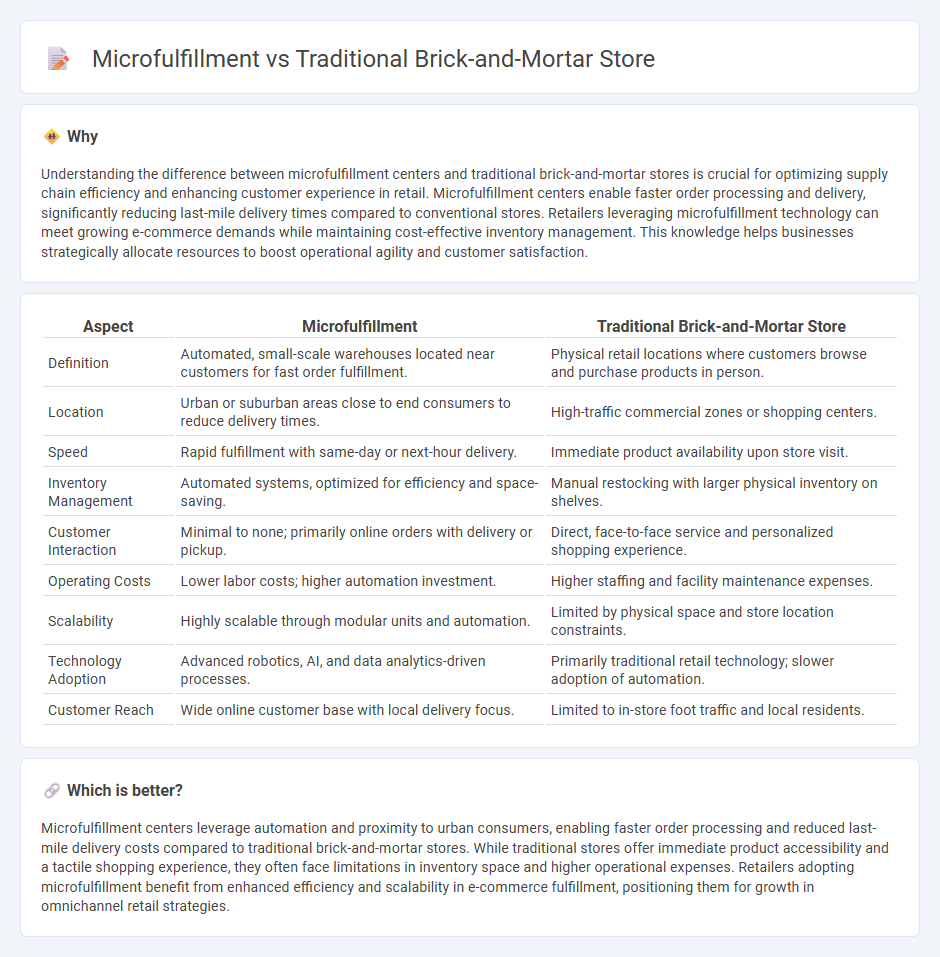
Microfulfillment centers leverage automation and smaller footprints to expedite order fulfillment in urban areas, contrasting traditional brick-and-mortar stores that depend on larger physical locations and manual inventory management. This approach reduces delivery times and operational costs while enhancing customer convenience in the retail sector. Explore how microfulfillment is transforming retail logistics and consumer experiences.
Why it is important
Understanding the difference between microfulfillment centers and traditional brick-and-mortar stores is crucial for optimizing supply chain efficiency and enhancing customer experience in retail. Microfulfillment centers enable faster order processing and delivery, significantly reducing last-mile delivery times compared to conventional stores. Retailers leveraging microfulfillment technology can meet growing e-commerce demands while maintaining cost-effective inventory management. This knowledge helps businesses strategically allocate resources to boost operational agility and customer satisfaction.
Comparison Table
| Aspect | Microfulfillment | Traditional Brick-and-Mortar Store |
|---|---|---|
| Definition | Automated, small-scale warehouses located near customers for fast order fulfillment. | Physical retail locations where customers browse and purchase products in person. |
| Location | Urban or suburban areas close to end consumers to reduce delivery times. | High-traffic commercial zones or shopping centers. |
| Speed | Rapid fulfillment with same-day or next-hour delivery. | Immediate product availability upon store visit. |
| Inventory Management | Automated systems, optimized for efficiency and space-saving. | Manual restocking with larger physical inventory on shelves. |
| Customer Interaction | Minimal to none; primarily online orders with delivery or pickup. | Direct, face-to-face service and personalized shopping experience. |
| Operating Costs | Lower labor costs; higher automation investment. | Higher staffing and facility maintenance expenses. |
| Scalability | Highly scalable through modular units and automation. | Limited by physical space and store location constraints. |
| Technology Adoption | Advanced robotics, AI, and data analytics-driven processes. | Primarily traditional retail technology; slower adoption of automation. |
| Customer Reach | Wide online customer base with local delivery focus. | Limited to in-store foot traffic and local residents. |
Which is better?
Microfulfillment centers leverage automation and proximity to urban consumers, enabling faster order processing and reduced last-mile delivery costs compared to traditional brick-and-mortar stores. While traditional stores offer immediate product accessibility and a tactile shopping experience, they often face limitations in inventory space and higher operational expenses. Retailers adopting microfulfillment benefit from enhanced efficiency and scalability in e-commerce fulfillment, positioning them for growth in omnichannel retail strategies.
Connection
Microfulfillment centers enhance traditional brick-and-mortar stores by enabling faster inventory replenishment and efficient last-mile delivery. These automated warehouses use advanced robotics and AI to process online orders quickly, supporting physical stores in meeting growing consumer demand for immediacy. Integration of microfulfillment solutions improves in-store stock availability and elevates the overall retail customer experience.
Key Terms
Foot Traffic
Traditional brick-and-mortar stores rely heavily on foot traffic, generating sales through physical customer visits and in-person experiences. Microfulfillment centers, by contrast, optimize inventory management and delivery speed, minimizing the need for store visits while enhancing e-commerce fulfillment efficiency. Discover how integrating microfulfillment can transform retail strategy and impact customer engagement.
Last-Mile Delivery
Last-mile delivery in traditional brick-and-mortar stores often relies on customers visiting physical locations, which can result in longer wait times and limited convenience. Microfulfillment centers leverage automation and proximity to urban areas to accelerate delivery speeds, enhance inventory accuracy, and reduce transportation costs. Explore how microfulfillment technology transforms last-mile logistics for e-commerce efficiency and customer satisfaction.
Automation
Microfulfillment centers leverage advanced automation technologies like robotics and AI-driven inventory systems to boost efficiency and reduce order processing time compared to traditional brick-and-mortar stores. These facilities enable rapid fulfillment by optimizing space utilization and minimizing human error, leading to faster delivery and improved customer satisfaction. Explore how automation in microfulfillment can transform retail logistics and operational costs.
Source and External Links
What Is a Brick and Mortar Store? Top 10 Retail Examples - A traditional retail business with a physical storefront where customers can visit, see, try, and purchase products in person, offering hands-on experience and immediate personalized services.
Brick and Mortar Stores: Types, Benefits, Examples (2024) - Shopify - Physical stores where customers browse, try, and buy products with in-person assistance, often serving as hubs for omnichannel retail strategies like in-store pickup or returns.
Brick-and-Mortar Stores: Key Definition, Pros, and Cons - Metrobi - Physical retail locations where customers shop face-to-face, including department stores, specialty shops, supermarkets, and convenience stores, providing sensory experiences that online shopping lacks.
 dowidth.com
dowidth.com